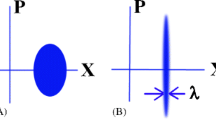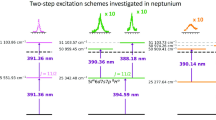Abstract
Recent investigations of the electron dynamics of molecules after irradiation with a short, strong XUV pulse have shown that under certain conditions, a rather clean deep hole state can be generated which, in turn, leads to a remarkable dipole instability. Here we analyze in more depth the dipole instability, simplifying the excitation mechanism by instantaneous generation of a hole in one of the occupied states of the system. We investigate how the dipole instability depends on the system, the state in which the hole is cut, and the amount of depletion which is given to the hole state. We also quickly discuss the mechanism beyond the dipole instability in analogy to the generation of a coherent photon field in a laser.



Similar content being viewed by others
References
F. Krausz, M. Ivanov, Rev. Mod. Phys. 81, 163 (2009)
F. Calegari, G. Sansone, S. Stagira, C. Vozzi, M. Nisoli, J. Phys. B 49 (2016)
M. Kitzler, S. Gräfe, Ultrafast Dynamics Driven by Intense Light Pulses (Springer International Publishing, New York, 2015)
D.R. Austin, A.S. Johnson, F. McGrath, D. Wood, L. Miseikis, T. Siegel, P. Hawkins, A. Harvey, Z. Masin, S. Patchkovskii et al., Sci. Rep. 11, 2485 (2021)
R. Weinkauf, P. Schanen, A. Metsala, E.W. Schlag, M. Buergle, H. Kessler, J. Phys. Chem. 100, 18567 (1996)
L. Cederbaum, J. Zobeley, Chem. Phys. Lett. 307, 205 (1999)
F. Remacle, R.D. Levine, E.W. Schlag, R. Weinkauf, J. Phys. Chem. A 103, 10149 (1999)
A.I. Kuleff, N.V. Kryzhevoi, M. Pernpointner, L.S. Cederbaum, Phys. Rev. Lett. 117, 093002 (2016)
C.E.M. Gonçalves, R.D. Levine, F. Remacle, Phys. Chem. Chem. Phys. 23, 12051 (2021)
F. Khalili, M. Vafaee, B. Shokri, Phys. Chem. Chem. Phys. 23, 23005 (2021)
P.-G. Reinhard, D. Dundas, P.M. Dinh, M. Vincendon, E. Suraud (2022), arXiv:2205.09997
L.S. Cederbaum, W. Domcke, J. Schirmer, W.V. Niessen, Adv. Chem. Phys. 65, 115 (1986)
R.M. Dreizler, E.K.U. Gross, Density Functional Theory: An Approach to the Quantum Many-Body Problem (Springer-Verlag, Berlin, 1990)
J.P. Perdew, Y. Wang, Phys. Rev. B 45, 13244 (1992)
E. Fermi, E. Amaldi, Accad. Ital. Rome 6, 117 (1934)
C. Legrand, E. Suraud, P.-G. Reinhard, J. Phys. B 35, 1115 (2002)
P. Klüpfel, P.M. Dinh, P.-G. Reinhard, E. Suraud, Phys. Rev. A 88, 052501 (2013)
P.-G. Reinhard, E. Suraud, Theoret. Chem. Acc. 140, 63 (2021)
S. Goedecker, M. Teter, J. Hutter, Phys. Rev. B 54, 1703 (1996)
P.M. Dinh, M. Vincendon, F. Coppens, E. Suraud, P.-G. Reinhard, Comput. Phys. Comm. 270, 108155 (2022)
H. Haken, Laser Theory (Springer, Berlin, 1984)
P.-G. Reinhard, E. Suraud, Ann. Phys. (N.Y.) 354, 183 (2015)
M. Vincendon, E. Suraud, P.-G. Reinhard, Eur. Phys. J. D 71, 179 (2017). https://doi.org/10.1140/epjd/e2017-80067-0
C.S. Cucinotta, D. Hughes, P. Ballone, Phys. Rev. B 86, 045114 (2012)
Acknowledgements
For computational resources, we acknowledge support from the RRZE (Regionales Rechenzentrum Erlangen).
Author information
Authors and Affiliations
Corresponding author
Additional information
Communicated by Guest editors: Franck Lépine, Lionel Poisson.
Ultrafast Phenomena from attosecond to picosecond timescales: theory and experiments.
Rights and permissions
Springer Nature or its licensor (e.g. a society or other partner) holds exclusive rights to this article under a publishing agreement with the author(s) or other rightsholder(s); author self-archiving of the accepted manuscript version of this article is solely governed by the terms of such publishing agreement and applicable law.
About this article
Cite this article
Reinhard, PG., Dinh, P.M., Dundas, D. et al. On the stability of hole states in molecules and clusters. Eur. Phys. J. Spec. Top. 232, 2095–2099 (2023). https://doi.org/10.1140/epjs/s11734-022-00676-6
Received:
Accepted:
Published:
Issue Date:
DOI: https://doi.org/10.1140/epjs/s11734-022-00676-6




